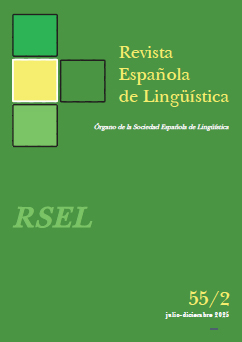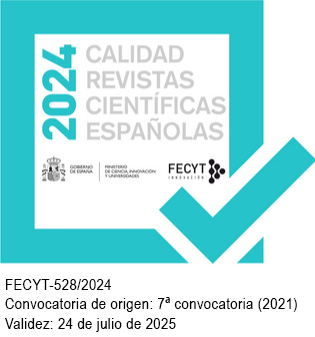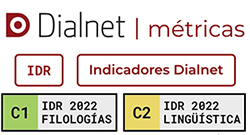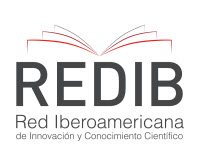Pilot Study on Spanish Familect: Methodological Optimization and Implications for Sociolinguistics
doi: https://doi.org/10.31810/rsel.55.2.2
Keywords:
familect, colloquial Spanish, sociolinguistics, linguistic typology, Spanish varietiesAbstract
The familect can be defined as the linguistic variety associated with family units, namely, groups of kin people living together. However, this term has not been accepted by Spanish sociolinguistics and represents a controversial, but interesting area of research. In this paper, the typological characteristics of esoteric languages (those used by small communities of speakers forming dense networks) have been used to sketch a preliminary characterization of the familect in Spanish. The resulting hypotheses have been checked via the collection and analysis of an original pilot corpus comprising daily conversations from 5 families living in two towns from the metropolitan area of Seville (Gines and Dos Hermanas). Results have been further compared with colloquial Spanish. We conclude that the familect should be regarded as a differentiated sociolect.
Downloads
References
Bajo Pérez, E. (2020). ¿Morfología excéntrica del verbo?: El diminutivo en los pretéritos perfectos compuestos de las coplas flamencas. Universitas studiorum editrice.
Beinhauer, W. (1968) El español coloquial, Editorial Gredos.
Benítez Burraco, A. & Felíu-Arquiola, E. (2024) De la variación tipológica a la variación intralingüística (y viceversa): el caso de los familectos. Revista Española de Lingüística, 54, pp. 9–28. doi: https://doi.org/10.31810/rsel.54.1.1
Bogard, S. (1999) Construcciones antipasivas en español, Nueva Revista de Filología Hispánica, 47, pp. 305–327. doi: https://doi.org/10.24201/nrfh.v47i2.2103
Briz, A. (1996). El español coloquial: situación y uso. ArcoLibros.
Briz, A. (1998). El español coloquial en la conversación: esbozo de pragmagramática. Ariel.
Briz, A. (2010). Lo coloquial y lo formal, el eje de la variedad lingüística. En R. Castañer Martín, & V. Lagüéns Gracia (coords.), De moneda nunca usada: estudios dedicados a José Mª Enguita Utrilla, pp. 125–133. CSIC.
Briz, A. & Grupo Val.Es.Co. (2002). Corpus de conversaciones coloquiales. Anejo de la revista Oralia. Arco Libros.
Calsamiglia, H. & Tusón, A. (2001). Las cosas del decir. Manual de análisis del discurso. Editorial Ariel.
Canary, D. J., & Stafford, L. (1992) Relational maintenance strategies and equity in marriage, Communication Monographs, nº 59, pp. 243–267. doi: https://doi.org/10.1080/03637759209376268
Chen, S., Gil, D., Gaponov, S., Reifegerste, J., Yuditha, T., Tatarinova, T., Progovac, L., & Benítez-Burraco, A. (2024). Linguistic correlates of societal variation: A quantitative analysis. PloS one, 19. doi: https://doi.org/10.1371/journal.pone.0300838
Clancy, B. (2016). Investigating intimate discourse. Exploring the spoken interaction of families, couples and friends. Routledge.
Cortés Rodríguez, L. (1991): Sobre conectores, expletivos y muletillas en el español hablado. Ágora (2002) Las unidades del discurso oral. Boletín de Lingüística, 17, pp. 7–29.
Gallego Uribe, S. (2006) Comunicación familiar: un mundo de construcciones simbólicas y relacionales, Editorial Universidad de Caldas
Galvin, K., Braithwaite, D. O., Schrodts. P., Bylund, C. L. (2004) Family Communication: cohesión and Change, Allyn & Bacon. doi: https://doi.org/10.4324/9781315228846
Gaviño Rodríguez, V. (2023). Español coloquial. Universidad de Cádiz.
Givón, T. (1979). On Understanding Grammar. Academic Press.
Gordon, C. (2009). Making meanings, creating family: Intertextuality and framing in family interaction. Oxford University Press.
Gottman, J.M., Krokoff, L.J. (1989). Marital interaction and satisfaction: a longitudinal view. J Consult Clin Psychol, 57, 47–52. doi: https://doi.org/10.1037/0022-006X.57.1.47.
Gregory, M. & Carroll, S. (1986). Lenguaje y situación: variantes del lenguaje y sus contextos sociales. FCE.
Gutiérrez Ordóñez (1997) La oración y sus funciones, Arco Libros.
Herrero, G. (1990). La lengua coloquial: concepto y factores que la caracterizan. Anuario de Lingüística Hispánica 6, 255–278.
Huston, T. L., & Vangelisti, A. L. (1991). Socioemotional behavior and satisfaction in marital relationships: A longitudinal study. Journal of Personality and Social Psychology, 61, 721–733. doi: https://doi.org/10.1037/0022-3514.61.5.721
Kay, P., (1977) Language evolution and speech style. En B. G. Blount, B.G.& M. Sanches, M. (Eds.), Sociocultural Dimensions of Language Change, pp. 21–33. Academic Press.
Kempe, V., Brooks, P. J., Gillis, S., & Samson, G. (2007). Diminutives facilitate word segmentation in natural speech: cross-linguistic evidence. Memory & Cognition, 35, 762–773. doi: https://doi.org/10.3758/bf03193313
Koch, P. & Oesterreicher, W. (2007). Oralidad y escrituralidad a la luz de la teoría del lenguaje. Lengua hablada en la Romania: español, francés, italiano (Trad. de López Serena), pp. 20–42. Gredos. (Trabajo original publicado en 1990).
Levenson, R. W., & Gottman, J. M. (1985). Physiological and affective predictors of change in relationship satisfaction. Journal of Personality and Social Psychology, 49, 85–94. doi: https://doi.org/10.1037/0022-3514.49.1.85
López Serena, A. (2007). El concepto de ‘español coloquial’: vacilación terminológica e indefinición del objeto de estudio. Oralia, 10, 161–191.
Lust, B. C. (2006). Child Language: Acquisition and Growth. Cambridge University Press.
Marqueta Gracia, B. (2017). Prefijos preposicionales y compuestos con preposiciones: dos fenómenos independientes. Lingüística en la red, 16, pp. 1–24.
Marqueta Gracia, B. (2020). La delimitación entre compuestos y aposiciones en español. En M. Martínez Atienza de Dios (ed.), En torno a la delimitación de determinadas categorías lingüísticas, pp. 71–90. De Gruyter.
Montero Curiel, M. L. (2011). Mola mogollón: la superlación morfológica y léxica en el lenguaje juvenil. Revista de estudios de juventud, 93, 89–104.
Narbona, A. (2012). Los estudios sobre el español coloquial y la lingüística, XLI Simposio de la Sociedad Española de Lingüística, Universitat de València.
Narbona, A. (2018). Sintaxis del español coloquial. Editorial Universidad de Sevilla.
Narbona, A., Sánchez, M. P., & Lázaro Carreter, F. (1993). El español hablado en Andalucía. Ariel.
Osovska, I. M. (2019). Lexical-semantic space of the German family discourse. Bialyk, V. D., Didukh, L. I., Yu, M. (eds.), Efficiency level and the necessity of influence of philololgical sciences on the development of language and literature: collective monograph, pp. 123–144. Liha-Press. doi: https://doi.org/10.36059/978-966-397-170-4/123-144
Roberts, J. (2013). Child language variation. En J. K. Chambers y N. Schilling(eds.), The Handbook of Language Variation and Change, pp. 263–276. Wiley-Blackwel. doi: https://doi.org/10.1002/9781118335598.ch12
Schick, J., Fryns, C., Wegdell, F., Laporte, M., Zuberbühler, K., van Schaik, C. P., et al. (2022). The function and evolution of child-directed communication. PLoS Biology, 20, e3001630. doi: https://doi.org/10.1371/journal.pbio.3001630
Seco, M. (1972). Gramática esencial del español: introducción al estudio de la lengua. Front Cover.
S∅ndegaard, B. (1991). Switching between seven codes within one family—a linguistic resource. Journal of Multilingual and Multicultural Development, 12, pp. 85–92. doi: https://doi.org/10.1080/01434632.1991.999448
Trudgill, P. (2011), Sociolinguistic Typology. Social Determinants of Linguistic Complexity. Oxford University Press.
Val Álvaro, J. F. (1999). La composición. En I. Bosque & V. Demonte (coords.), Gramática descriptiva de la lengua española, pp. 4757–4838. Espasa Calpe.
Vangelisti, A. L. (2004). Handbook of family communication. Routledge Communication Series.
Vigara Tauste, A. M. (1992). Morfosintaxis del español coloquial. Gredos.
Wertheimer, M. (1973). Toward a Phenomenological Psycholinguistics of Multilingualism. En D. Krech (Ed.), The MacLeod Symposium (pp. 1-17). Cornell University.
Wray, A., & Grace, G. W. (2007). The consequences of talking to strangers: Evolutionary corollaries of socio-cultural influences on linguistic form. Lingua, 117, 543–578. doi: https://doi.org/10.1016/j.lingua.2005.05.00
Published
How to Cite
Issue
Section
Copyright (c) 2025 Revista Española de Lingüística

This work is licensed under a Creative Commons Attribution-NonCommercial-NoDerivatives 4.0 International License.











